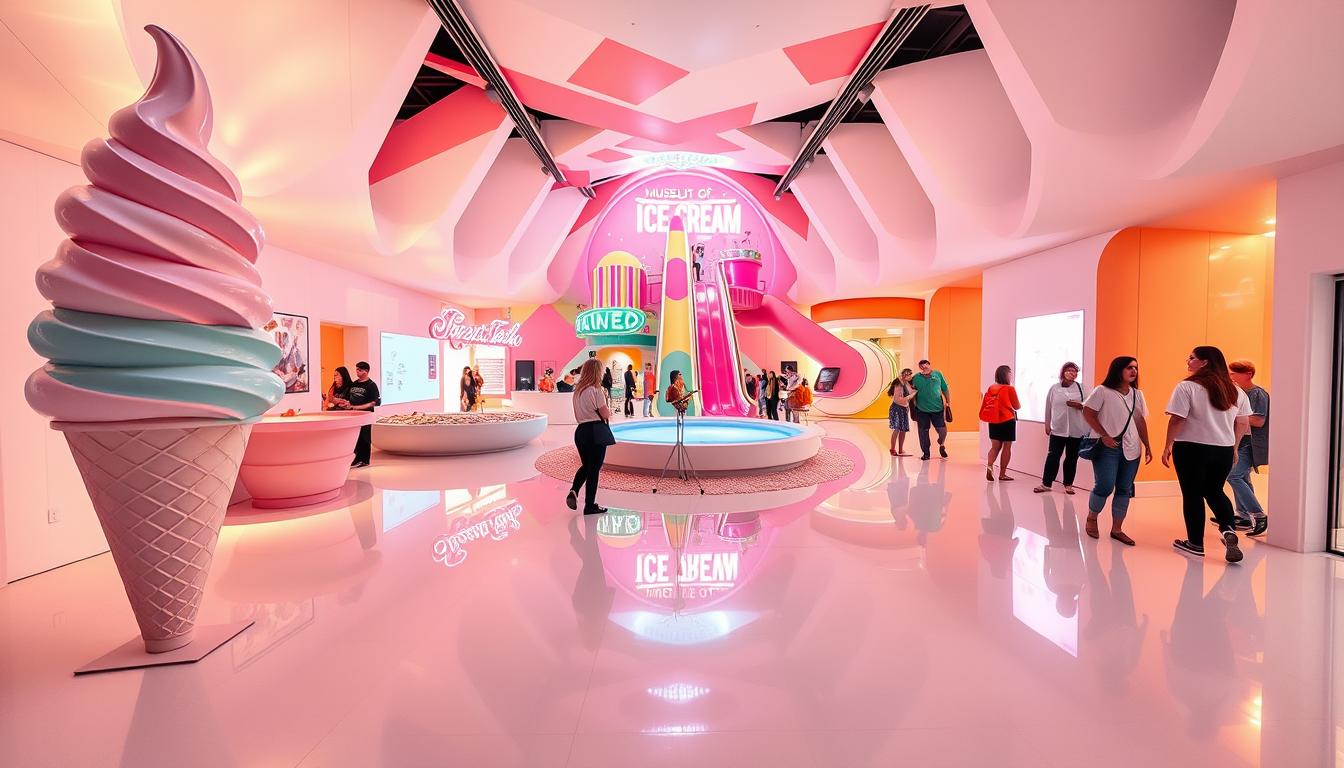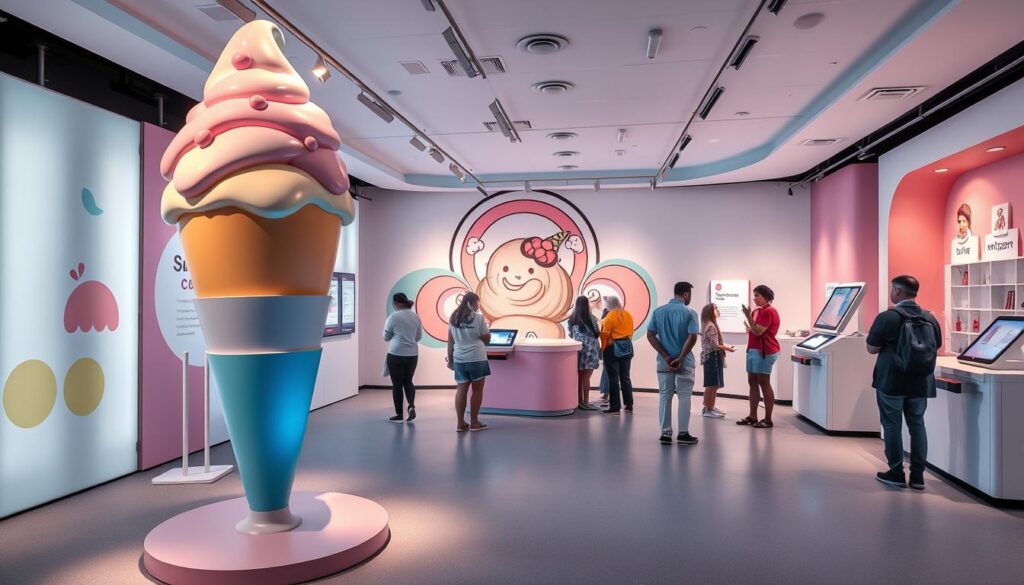
Imagine a place where the line between reality and social media blurs, and every corner is designed to be shared. Welcome to the Museum of Ice Cream, where over 30,000 tickets were sold in just a few weeks during its 2016 launch in Manhattan, leaving 200,000 people on the waitlist. This isn’t just a museum—it’s a masterclass in creating experiences that go viral.
Since its debut, the Museum of Ice Cream has expanded to cities like Los Angeles, Miami Beach, and San Francisco, becoming a cultural phenomenon. Its secret? A perfect blend of interactive exhibits, aesthetic appeal, and strategic brand partnerships with companies like Tinder, Sephora, and Target. Each installation is crafted to be as photogenic as it is fun, turning visitors into content creators.
What makes this museum unique is its shift from traditional art to a pop-up experience focused on viral pictures. It’s a space where art meets commerce, and every moment is designed to be shared. Whether you’re sliding down a three-story slide or snapping a photo in a sprinkle pool, the Museum of Ice Cream proves that in today’s digital age, the most valuable experiences are those that create social media gold.
Learn how this innovative approach has transformed the Museum of Ice Cream into a case study for modern marketing success. Discover the strategies behind its viral content and how it’s redefining the future of social engagement and brand-building in the digital world.
Understanding the Impact of Instagram on Museum Experiences
Today, museums are no longer just spaces for quiet reflection and art appreciation. They’ve transformed into vibrant hubs where digital interaction plays a central role. The rise of platforms like Instagram has reshaped how people engage with cultural and artistic experiences.
The Evolution of Museum Culture in the Digital Age
In the past, museums were seen as formal institutions where visitors would admire art from a distance. Now, they’ve embraced a more interactive approach. This shift is driven by the demand for shareable moments. The Museum of Ice Cream is a prime example, where every exhibit is crafted to be both fun and photogenic.
Photo Ops and the Demand for Instagram-Worthy Moments
Visitors now seek experiences that are as visually striking as they are memorable. The sprinkle pool and themed exhibits at the Museum of Ice Cream are designed to encourage social media sharing. These installations create moments that are perfect for Instagram feeds, blending art with commerce.
| Aspect | Traditional Museums | Modern Interactive Experiences |
|---|---|---|
| Focus | Art appreciation and education | Interactive and photogenic exhibits |
| Visitor Behavior | Passive observation | Active participation and sharing |
| Exhibit Design | Static displays | Dynamic, immersive installations |
This evolution reflects a broader cultural shift. Museums now cater to a generation that values experiences over possessions. By integrating interactive and visually appealing elements, they attract a younger audience and build a strong online presence.
Ice Cream Museum Instagram Strategy: Turning Sweet Experiences into Viral Content
Step into a world where every moment is crafted to captivate and inspire sharing. The Museum of Ice Cream has mastered the art of creating experiences that resonate far beyond its walls.
Engaging Tactics That Boost Social Media Presence
The museum’s success lies in its ability to blend aesthetics with interactivity. Exhibits like the iconic sprinkle pool and Tinder Land are designed to be as fun as they are photogenic. These installations encourage visitors to pause, snap, and share, turning each moment into potential social media gold.
Creating Viral Content Through Aesthetic and Interactive Elements
Strategic partnerships with brands like Sephora and Tinder enhance the museum’s appeal. These collaborations create branded experiences that visitors eagerly share online. The museum’s approach ensures a balance between fun and content creation, making every interactive element a deliberate step toward viral success.
| Feature | Traditional Approach | Modern Approach |
|---|---|---|
| Focus | Static displays | Interactive, photogenic exhibits |
| Visitor Interaction | Passive observation | Active participation |
| Design | Functional | Aesthetic, immersive |
By focusing on shareable moments and partnerships, the Museum of Ice Cream has redefined how cultural experiences engage with digital audiences. Learn more about how this approach has created a new model for social media-driven attractions.

Lessons from Social Media Trends: Myspace’s Stagnation vs Facebook’s Simplicity and Innovation
Understanding the rise and fall of social media platforms offers valuable insights into what drives success in the digital age. The contrasting trajectories of Myspace and Facebook provide a clear blueprint for creating engaging experiences that resonate with audiences.
Myspace’s Failure to Innovate and Its Impact on User Experience
Myspace, once a pioneer in social networking, struggled with sluggish innovation and a cluttered user interface. Its decline from 70 million monthly users in 2008 to under 1 million by 2019 highlights the consequences of poor design and misguided acquisitions. The platform’s failure to simplify and adapt left users seeking more streamlined experiences.

How Facebook’s Focus on Simplicity Transformed Social Engagement
Facebook’s rise to 1 billion active users by 2012 underscores the power of simplicity and user-focused design. By prioritizing clean interfaces and intuitive features, Facebook created a platform that fostered genuine social engagement. With 75% of users accessing the site daily and averaging 38 minutes per session, Facebook’s approach set a new standard for social media platforms.
To engage readers, consider a timeline challenge: identify key moments where Myspace could have pivoted strategy. Reflect on how its decisions affected user experience and market position, drawing parallels to the Museum of Ice Cream’s strategic use of Instagram for viral content and brand partnerships.
These lessons emphasize the importance of adaptability and user-centric design. By learning from Myspace’s missteps and Facebook’s successes, the Museum of Ice Cream crafted experiences that blend art and commerce, creating social media gold. Explore strategies that transform experiences into engaging, shareable moments, mirroring the Museum’s innovative approach to social engagement and brand-building in the digital world.
Conclusion
In today’s digital age, the Museum of Ice Cream stands as a testament to how social media can redefine cultural experiences. By blending art, commerce, and interactivity, it has created a space where every moment is designed to be shared. The museum’s success lies in its ability to craft experiences that resonate far beyond its walls, turning visitors into content creators.
The evolution of museum experiences in the digital age highlights the shift from static displays to interactive, photogenic exhibits. This transformation reflects a broader cultural shift, where visitors value experiences over possessions. The Museum of Ice Cream exemplifies this change, attracting a younger audience and building a strong online presence through its aesthetic appeal and strategic partnerships.
Lessons from the rise and fall of social media platforms like Myspace and Facebook emphasize the importance of innovation and simplicity. The Museum of Ice Cream’s strategic use of Instagram to create viral content and its focus on interactive design underscore these principles. By adapting to digital trends, the museum has redefined how cultural experiences engage with audiences.
As you reflect on the role of technology in shaping cultural experiences, consider how digital trends influence your interactions with art and interactive environments. Take the timeline challenge to identify key moments where Myspace could have pivoted its strategy, drawing parallels to the Museum of Ice Cream’s approach. Explore strategies that transform experiences into engaging, shareable moments, mirroring the Museum’s innovative approach to social engagement and brand-building in the digital world.

 Ice Cream Museum Instagram Strategy: Turning Sweet Experiences into Viral Content
Ice Cream Museum Instagram Strategy: Turning Sweet Experiences into Viral Content
0 Comment